The Ultimate year: 12 months that forged a legend
Play the game.
With the multiplayer plundering game Sea Of Thieves creating waves, it's an appropriate time to think back to 35 years ago, when Rare's founders, the Stamper brothers, Tim and Chris, first gave gamers a glimpse of their creative skills. 1983 was the year of the ZX Spectrum, at least in the UK; the computer had been released in April the year before, but with Sinclair's high-falutin' ideals of the machine assuming a central role for the entire family - an artistic tool, office and school all rolled into one - it wasn't until later in 1982 that most people realised there was a huge potential in the field of entertainment software. In other words, video games, and the Stampers were one of many entrepreneurs starting up early in 1983 with the sole purpose of producing games for the Spectrum and, eventually, its rival computers.
Ultimate Play The Game became the trading name for Ashby Computers and Graphics Ltd, based in the brothers' home town of Ashby-de-la-Zouch, Leicestershire. While Ultimate would be rightly famous for its isometric games of the mid-Eighties, it was the below sextet of impressive titles released in its first year of trading that established the software house as a home for high-quality gaming and a testament to the simple, joyous entertainment of these games that they still retain much of their charm 35 years later. In their day they caused a stir graphically, and while in the cold light of 2018 the games may not look like much, that purity of gameplay never fades. So here they are, those six enthralling, challenging, frustrating and energetic games from the Ultimate first year...
Jetpac (May 1983)
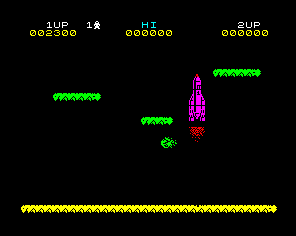
Released in late spring 1983, Jet Pac was Ultimate's first game, and like most of its early efforts, coded in just 16k. It began the story of Jetman, a test pilot assigned the task of assembling rockets for the Acme Interstellar Transport Company. Within its one-screen display lay individual parts of each rocket; each had to be collected and assembled, in the correct order, before also collecting fuel for the spaceship. Jetpac began Ultimate's tradition of technically impressive, yet also amiably fun videogames. Jetman's colourful laser and the swift momentum-infused movement was a marvel to behold in an era where many commercial games were still being produced in BASIC, and it secured the inaugural Golden Joystick award of game of the year while gaining flattering comparisons with arcade machines of the time. Not bad for a first effort and, as with several of Ultimate's early titles, Jetpac was also released on ROM cartridge - for almost three times the price of the cassette version.
What they said: "Jetpac is a very playable, addictive and original arcade game. The graphics are superb and [it] comes complete with a five year unconditional guarantee which can't be bad." Computer and Video Games Magazine, Spring 1983
Pssst (June 1983)
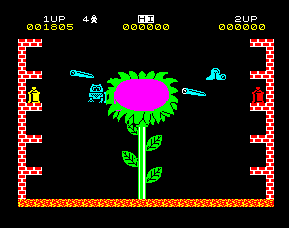
The Stampers were efficient workaholics, so it was no surprise to see more games quickly appear from their new company. Arriving in an atmosphere of heightened anticipation following the success of Jetpac, Pssst contained an altogether different theme, albeit coupled with a similar style of gameplay. Here, the player took on the role of a cute robot named Robbie, whose task was to protect a giant plant known as a Thyrgodian Megga Chrisanthodil, from infant bud to full-grown monster flower. Hungrily attacking the plant were a range of space slugs and insects, and these could be dispatched using the relevant colour-coded can of insecticide of which the robot could, naturally, only carry one at a time. Again a one-screen game, Pssst didn't offer much new, but was still a professionally-produced piece of software that once more ran on just 16k of memory. And like Jetpac, the game was deceptively easy to start; it wasn't long before Robbie was racing manically around the screen as more and more bugs threatened his precious flower.
What they said: "[Its] graphics are smooth-moving and colourful and the sound effects are tuneful rather than noisy. Definitely an addictive game." Home Computing Weekly, July 1983
Cookie (October 1983)
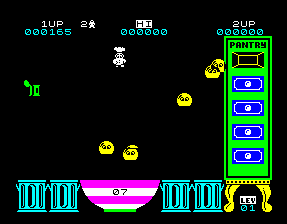
Following hot on the angular robotic heels of Pssst were Cookie and Tranz Am, both released in the summer of 1983. Cookie was yet another one-screen game as, in a cavalcade of wince-inducing alliteration (such as Crafty the Cheese and Sneaky Sugar), the player's tubby chef threw bags of flour at errant ingredients in order to knock them into his waiting mixing bowl. Completing the process five times resulted in the chef's cake rising from the bowl, before it was back to the start, only faster, harder and meaner. Despite its multi-coloured display and frantic gameplay, Cookie drew criticism for its similarity to Pssst, as well as its high demand on the player's reflexes. But the Stampers, always looking ahead, knew they had to change, as their next game demonstrated.
What they said: "Cookie is everything that you could ask for in a game. The graphics and sound are superb, the concept is original and the presentation is professional." Sinclair User, October 1983
Tranz Am (July 1983)

Tranz Am aptly showed how the Stamper brothers, even at this early stage, refused to rest on their laurels. It would have been easy to produce another single-screen game, perhaps with better graphics and sound. Instead, they developed a thrilling race game that, while technically impressive, didn't quite hit the heights of their earlier efforts. Tranz Am took place in the year 3472, within a barren wasteland, formerly known as the United States Of America. The player sat behind the wheel of a souped-up racing car (reminiscent of the vehicle from arcade racer Rally-X), ready to race across the continent in search of the eight mythical cups of Ultimate. Tranz Am was the first Ultimate game to use multi-scrolling, and the Stampers ensured it worked smoothly and swiftly, giving the game an exciting and instant playability, despite noted reservations of its long-term appeal.
What they said: "The graphics, sound and presentation are all of the highest quality. A very well-written and addictive game." Popular Computing Weekly, September 1983
Lunar Jetman (November 1983)
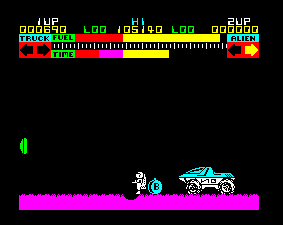
The second story in the saga of Jetman firmly established Ultimate's reputation for not just quality games, but also rock-hard ones. Following directly on from Jetpac, it's transpired that Jetman isn't quite as adept at constructing rockets as we thought. His craft having disintegrated in space, the poor spaceman has landed on a hostile planet, chock-full of aliens intent on the destruction of Earth. The surface of the planet is peppered with large missile bases; unable to warn his home planet, Jetman must destroy all the installations, with only his moon rover to help him. Thanks to its well-defined graphics, scrolling landscape and colourful laser gun fire, Lunar Jetman should have been a joy to play, and scored highly in the press of the time. In reality, its arduous level of difficulty meant even the most devoted of Spectrum gamer was unlikely to proceed very far, let alone locate the mythical moon rover trailer that featured on the game's cover. Lunar Jetman also marked the end of Ultimate's 16k games, coming as it did on a whopping 48k.
What they said: "This is the most maddening and excitingly frustrating game Ultimate have come up with. The graphics are richly coloured [and] highly detailed. What can you say? Marvellous seems inadequate." Crash Magazine, February 1984
Atic Atac (early 1984)
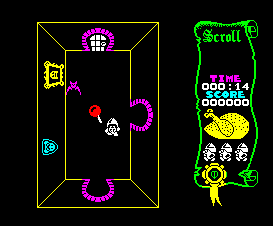
Atic Atac trumped all of Ultimate's previous games, both in terms of gameplay and its technical achievement, and as such is one of its most fondly remembered today. In a change of perspective, the Stampers used cleverly worked graphics and lines to present an effective top-down, semi-3D view of the action. The setting is a haunted castle of five floors, full of ghosts, ghouls and other strange monsters. In addition to its fantastic looks, Atic Atac introduced a number of interesting gameplay elements. Most notably, in a move virtually unheard of for Spectrum games in 1983, the player had the choice of three characters, a knight, serf or wizard. Each had their own method of attack, and crucially, use of a particular secret set of passages that the other characters could not access. The player's task was simply to escape the imposing fortress by assembling several parts of the Golden Key of ACG, which would then unlock the castle's main doors. Skilful manipulation of the various door keys and a good memory for the game's map were essential, and Atic Atac remains a delight to play today, with its vivid graphics, fast character movement and cartoonlike charm, typified by the gravestone that appeared whenever the player lost a life.
What they said: "The graphics...just marvellous. But the details of events is also fantastic. Ultimate have done it again." Crash Magazine, issue 2 March 1984









